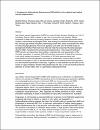A low glycemic diet protects disease-prone Nrf2-deficient mice against age-related macular degeneration.

Date
2020-04-01Author
Rowan, SheldonJiang, Shuhong
Chang, Min-Lee
Volkin, Jonathan
Cassalman, Christa
Smith, Kelsey M
Streeter, Matthew D
Spiegel, David A
Moreira-Neto, Carlos
Rabbani, Naila
Thornalley, Paul J
Smith, Donald E
Waheed, Nadia K
Taylor, Allen
...show more authors ...show less authors
Metadata
Show full item recordAbstract
Age-related macular degeneration (AMD) is a major blinding disease, affecting over 14% of the elderly. Risk for AMD is related to age, diet, environment, and genetics. Dietary modulation of AMD risk is a promising treatment modality, but requires appropriate animal models to demonstrate advantages of diet. Mice lacking the antioxidant transcription factor Nrf2 (Nfe2l2) develop age-related retinopathy relevant to human AMD. Here we evaluated the effect of consuming high glycemic (HG) or low glycemic (LG) diets until 18-months of age on development of features relevant to AMD in Nrf2-null mice. Nrf2-null mice that consumed HG diets developed atrophic AMD, characterized by photoreceptor degeneration, retinal pigment epithelium (RPE) atrophy and pigmentary abnormalities, basal laminar deposits, and loss of the choriocapillaris. In contrast, Nrf2-null-mice that consumed LG diets did not develop retinal disease phenotypes. Consumption of HG diets was associated with accumulation of advanced glycation end-products in the RPE and systemically, whereas consumption of the LG diet was associated with increased levels of anti-glycative and anti-oxidative detoxification machinery. Together our data indicate that the Nrf2-null HG mouse is a good model for atrophic AMD studies and that the LG diet can activate protective pathways to prevent AMD, even in a genetically predisposed animal.
Collections
- Medicine Research [1913 items ]


